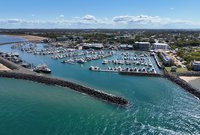Navigating The Surge: Opportunities in a Rising Market
2025 continues to bring excitement to the residential real estate market, with not only one but three cash rate cuts. As of August 2025, the cash rate was 3.6%, which is similar to the cash rate of April 2023. Of course, three cash cuts do not mitigate 13 cash rate hikes (since May 2022), however, with many major banks passing on the savings and lowering their interest rates for many products, it does assist those who have been “sticky” and waiting to enter the market.
Titled “Navigating the Surge: Opportunities in a Rising Market” PRD’s Australian Economic and Property Update for the 2nd half of 2025 aptly portrays how the current housing market is a catch-22, especially with monthly house price growth evident, regardless of whether it is a capital city or regional area location.
Interactive Online Report
- PC viewers: to view bigger, hover over the bottom of the slide to get the option to view in full screen.
- Mobile device viewers: to view bigger, pinch and zoom with your fingers. To navigate between slides, tap the slide for navigation arrows to appear, or swipe left or right between slides.
Download PDF Report
PRD Chief Economist, Dr. Diaswati Mardiasmo says “buyers can increase their purchase offer due to being able to increase their borrowing capacity, arming them in a highly competitive and undersupplied market. That said, higher offers can stimulate the lower and more affordable price bands within the market, causing affordability issues down the track (for future buyers).”
“Although there are still many moving pieces in both the global and domestic economy, the Australian economy has held resilient in terms of GDP growth, unemployment rates, and higher than average wage growth. This has assisted household budgets in tackling higher costs of living, and we are seeing a slight recovery in household savings, with the RBA predicting that it will return to the long-term average by around 2027,” Dr. Mardiasmo said.
“The 2nd half of 2025 is reflective of a less restrictive RBA policy, with consumer confidence growing at a rapid rate. At 98.5 index points in August 2025, it is the highest confidence we have seen since May 2022 (the start of cash rate hikes), suggesting buyers are back,” commented PRD Managing Director, Todd Hadley.
Key findings include:
- Buyers have returned and are more prepared than before. The time-to-buy-a-dwelling index saw a 37.0% improvement in the past 12 months (to August 2025), at 97.8 index points. This is the closest index reading to 100.0; which occurred in September 2021 (pre the 13 cash rate hikes). The highest growth was in Tasmania (113%) and New South Wales (48.3%). Opportunities for first home buyers exist in South Australia, with the lowest growth of 3.4%.
- Monthly house price growth has recovered in 2025, as cash rate cuts have stimulated demand. This decline was expected; however, Sydney and Melbourne continue to show moderated growth - creating an opportunity for buyers. In most capital cities, median unit price growth eclipsed median house price growth due to a lack of supply. Although units are still approximately 30-35% cheaper than houses, this may not last long.
- First home buyers’ activity increased by 15.8% increase in the past 12 months to June quarter 2025, and first home buyers must commit to a higher level of debt, an increase of 4.2% across Australia.
- Housing finance commitments increased by 14.4% in the past 12 months, reaching the March quarter of 2025. Investors are leading the pack, maintaining their position with a growth rate of 15.8%. The increase is good news for renters, as CPI and advertised rent prices have started to show a declining trend in early-to-mid-2025.
- New residential construction has continued to grow; by 15.2% in the past 12 months (until Q1 2025). At the same time, quarterly population change declined by -25.0% in the past 12 months (until Q4 2024). Combined with lower new dwelling cost inflation and an increase in private dwelling investment (for all property types), this decline brings hope to housing supply.
- Units remain the dominant planned ready-to-sell stock in 2024 and 2025 (and beyond) in almost all capital cities (except for Adelaide). Houses will remain undersupplied, pushing up prices for all stock types.
What’s in store for the rest of 2025 and early 2026?
“It is an exciting time for buyers and investors in the real estate market; more are making moves based on the possibility of more cash rate cuts. The RBA insists on a restrictive monetary policy but is optimistic that the inflation rate will remain within the 2-3.0% target rate. That said, domestic and international trade risks are still very real, which can impact Australian businesses and have a multiplier effect on both the labour market and wage growth.” Dr. Mardiasmo said.
“More buyers and higher prices are already evident; people are positive. As we enter the spring and summer months, it is now a race to secure your dream home. Buyers still need to be smart, ensuring they do not overcapitalise, and in some cases, will need to adjust or compromise on their preferences” Mr. Hadley said.







